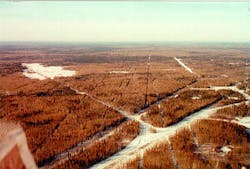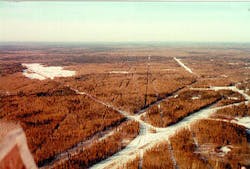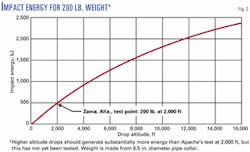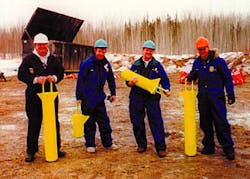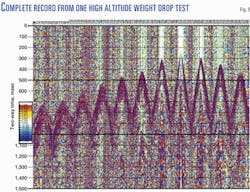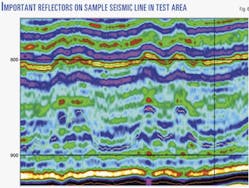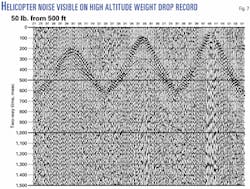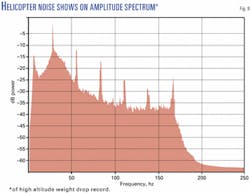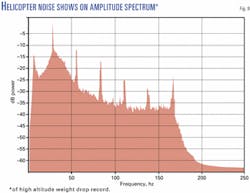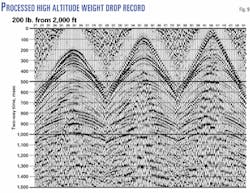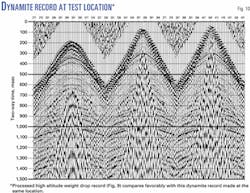Weight drop systems were some of the earliest, and in some areas most successful, seismic source systems ever used. Traditional systems typically used a 3-ton weight mounted on the back of a large truck which was allowed to free fall to the ground, thus generating a seismic "thump."
Weight drop systems are not currently popular and have largely been replaced with dynamite and Vibroseis sources for land exploration.
Dynamite has the advantage that it is easy to generate a very large impulsive energy source, and Vibroseis has the potential advantage of controlling the signal that is transmitted into the ground. However, both systems can be expensive and require a relatively large "footprint" area on the ground.
Faced with rapidly expanding exploration in Canada, last year Apache decided to look at the possibility of using a different weight drop system1 as a potential seismic source in forested areas where access can be very difficult. Conventional seismic sources lead to high cost surveys and an environmental legacy resulting from the clearance of lines through the trees for drill access.
Limiting surface access
Conventional seismic exploration in some areas is only possible with significant tree clearance and the resulting impact to the local environment.
Over the course of many years, continuing seismic activity can lead to problems in obtaining further permits and permissions because of the effects on the environment of older seismic activity.
Fig. 1 is a photograph of some of the cut lines through forestry in an area of northern Alberta. Some of these lines are cut for lumber harvest, but many of them are shot and receiver lines for past 2D and 3D seismic exploration. It would of course be desirable if the width and number of these lines could be reduced while still performing adequate seismic exploration.
High Altitude Weight Drop (HAWD) systems offer the potential for considerable reduction in environmental impact for several reasons.
First, there may be no requirement to cut access lines for shot points. If drop positions can be determined either from GPS at the time of drop, or at a later stage from the air, then there may be no requirement for surface access at all.
If the weights that are dropped can be made of a biodegradable or biofriendly material then there may be no requirement to retrieve the source weights, which could be left to thaw or decompose naturally.
The result could be a survey in which no surface access is required at all for source points. This would certainly minimize the environmental impact of seismic exploration in these areas.
Energy considerations
Increasing the energy for a weight drop system can be achieved in several ways. Broadly these are:
- Repeating the drop and adding records together.
- Dropping a larger weight.
- Accelerating the weight under a force greater than that of gravity.
- Dropping the weight from a greater height.
Options 1, 2, and 3 still present problems with limited access, but Apache was interested in examining the potential for dropping smaller weights from a much greater height.
Helicopter mounted systems are commonly used for moving seismic equipment, and a relatively easy adaptation holds the potential for high quality seismic data with little or no impact on the forested areas under exploration.
The seismic signal imparted into the ground from a weight drop system stems from the conversion of the kinetic energy of the mass when it hits the ground.
As a basis for comparison a conventional system uses a 6,000 lb (3 ton) weight that is dropped under the force of gravity a distance of 10 ft. The energy generated by such a source is approximately 81 kJoules.
An order of magnitude reduction in weight requires an order of magnitude increase in altitude to achieve the same result. So equivalent energy can be achieved using a 600 lb weight dropped from 100 ft or a 60 lb weight dropped from 1,000 ft.
Weights, shapes
It became apparent that relatively small, manageable weights could apparently be used to yield the same impact energy as very large weights on the back of a surface located system. In practice of course there is some loss of energy as falling objects can approach a terminal velocity because of the drag as the object falls through the air.
While the dragless case is approximately correct for very large weights falling only a relatively small distance, as drop heights increase the effect of wind resistance needs to be evaluated because drag will begin to effect the falling weight. Streamlined "bomb" shapes are very efficient and generate minimal drag.
In this case it is worth examining in more detail the real requirements for a weight drop from high altitude, and account for the drag forces which come into play. In particular Apache was interested in looking at weights that might be completely biodegradable (for example lumps of ice) as well as retrievable systems which might have to be removed at a later stage.
The drag properties of regular shapes are relatively easily examined, and Fig. 2 shows the predicted impact energy for a particular 200 lb weight dropped from various heights.
Field tests
On Mar. 29, 2001, Apache ran a series of tests in conjunction with a 3D seismic survey being conducted in the Zama area in Alberta.
Having identified a suitable test location (Fig. 3), a series of conventional dynamite source tests was conducted along with some high altitude weight drop tests. The site was well clear of roads, pipelines, and all other potential hazards on the surface.
High altitude drop tests were performed using a helicopter normally used for moving seismic equipment around the project. As such it was equipped with a 100 ft "long line" and carousel with 8 hooks which could be controlled by the pilot. It was therefore possible to attach a variety of specially designed weights and release these individually over the desired target area.
For test purposes, a set of 4 weights was constructed from 6.5-in. pipe collar, with weights of 50, 75, 150, and 200 lb. These are shown in Fig. 4. - Weights of 50, 75, 150, and 200 lb. were fashioned from 6.5-in. pipe collar. (Fig. 4)
The weights were constructed for this test with easy identification and retrieval in mind, but construction of biodegradable weights was examined as well. The temperature during the survey sometimes reached 40° below zero, and construction of ice weights would be relatively easy.
The weights were dropped in sequence from lower altitude to higher with increasing weight. This sequence was established to ensure that any potential safety issues were first examined with the smallest weight from the lowest altitude.
Positioning, recording
The helicopter was equipped with GPS navigation, and the location of the target was known. The initial drop of a 50 lb weight from an altitude of 500 ft landed within inches of the target. In each case drift calculations were performed before the drop based on reported wind.
The largest single impact achieved utilized a 200 lb weight from a height of 2,000 ft which should be expected to yield energy equivalent to more than 6 repetitions of a conventional 3-ton drop from 10 ft!
Data were recorded in each case into a full active spread from the 3D survey that was being acquired (a minimum of 594 live channels). Fig. 5 shows a complete record from one of the HAWD tests.
Exploration potential in this area is from fairly shallow formations that correspond to seismic times down to 1.1 sec. Important reflectors are between 800 msec and 1.1 sec as illustrated in Fig. 6. This technique should work well for deeper targets also, although a higher altitude drop might be appropriate.
Test results
The tests of the high altitude drops produced records which were much as expected, in that the signal-noise ratio improved with predicted impact energy. All impacts produced records with readily identifiable first breaks on all traces.
A comparison between the lightest impact and heaviest impact shows a distinct increase in energy and improvement in S/N.
One of the biggest noise sources on the seismic data was the helicopter itself. Noise levels were particularly high for lower altitude drop records, which would be an issue for a production system for drop altitudes less than 1,000 ft. The noise shows clearly on the record at 500 ft (Fig. 7) but is far more easily identified on an amplitude spectrum where the dominant frequency and harmonics are clear (Fig. 8).
Quieter helicopters can be used such as the MD 520N, which has no tail rotor (a primary noise source). Helicopters are available that would produce less noise at 1,000 ft than the test helicopter produced at 2,000 ft.
Dramatic improvement in seismic data is seen as the impact energy is increased. After processing, a close-up of a portion of the record achieved using the 200 lb weight from 2,000 ft, is shown in Fig. 9. This record has roughly 15 times the impact energy of data recorded with a 50 lb weight dropped from 500 ft and clearly shows the potential for successful data to be acquired using a high altitude weight drop system. Data compares very favorably with a conventional dynamite (3-hole pattern at 6 m using 1/2 kg of dynamite/hole) record from the same test location (Fig. 10).
Prior to the test, it was anticipated that some of the weights may not be retrievable because they would become buried in the ground.
The ground condition at the test site was hard-packed frozen clay, and in fact none of the weights buried into the ground to any distance. Surface effect was very localized leading to less than 1 in. of compaction.
Operating costs
Acquisition in forestry areas of Canada can be both expensive and difficult to permit. Apache's goal for these tests was to examine new source techniques, with less impact on the environment, which could be expected to yield the same quality of data or better.
In the survey area in which the test was held, a 3D survey was being conducted which allows reasonable price estimates to be examined for acquiring data in this area.
Costs in association with source points for the 3D survey were close to $160 (Canadian)/shotpoint; of this $85 is directly associated with drilling holes and cost of dynamite.
Helicopter rental in this area runs $1,500/hr, which means that breakeven costs compared to conventional dynamite operations would be achieved if 10 drop points/hr were achieved. This seems to be a very reasonable target, it is difficult to see why 30 or even 60 drops/hr could not be achieved.
It would of course be important to verify that data quality in the area is sufficient to justify the use of the method.
Source costs in this area of Canada are not particularly expensive, but access is expensive due to line cutting and snow removal. In other areas prone to difficult heliportable drilling, an order of magnitude reduction in source costs may be possible.
Wider application
High Altitude Weight Drop systems can produce records which are at least as good as conventional dynamite. A series of dynamite tests conducted separately shows that the result used here is representative of the best that can be achieved using dynamite.
While a production high altitude system may have some problems, all of these could be overcome relatively easily, and helicopter weight drop systems may well be a desirable source for many different areas. Some examples might be:
- North Slope of Alaska where access is easy, but production of ice weights would be particularly easy.
- Good-data areas in Canada under forestry, where high altitude weight drop would yield good data for considerably less cost, and with significantly less (or no) environmental impact.
- Jungle (example: Papua New Guinea) or heavily forested areas where access is very difficult and drilling is all heliportable.
- Areas of exploration where surface rocks are very hard, making drilling difficult and access for Vibroseis is not possible.
- Mountainous areas of the US or other continents where access is difficult due to terrain.
Reference
- Bahorich, P.A., and Bahorich, M.S., "A method for conducting seismic surveys utilizing an aircraft deployed seismic source," US and foreign patents pending, 1999.
The authors
David Monk joined Apache Corp. in January 1999 and is manager of seismic operations. Previously he was chief technical officer at Continuum Resources and president of Energy Innovations Technical Services. Recipient of the SEG best paper award in 1993 and the Hagedoorn Award in 1994, he holds five US patents and has published more than 60 papers. E-mail: [email protected]
Mike Bahorich is executive vice president, E&P technology for Apache. He received the 1998 Virgil Kauffman Gold Medal for the patented Coherence Cube. Earlier, he developed seismic interval/volume attribute mapping, now available on most geoscience workstation software platforms. He was recently elected as the next president of the Society of Exploration Geophysicists. E-mail: [email protected]
Phil Bahorich has 15 years of aerospace industry experience with McDonnell Douglas (now Boeing) and Parker Hannifin Corp. He resides in Huntington Beach, Calif. He has a BS degree in aerospace engineering from the University of Kansas and is a private pilot. E-mail: [email protected]
